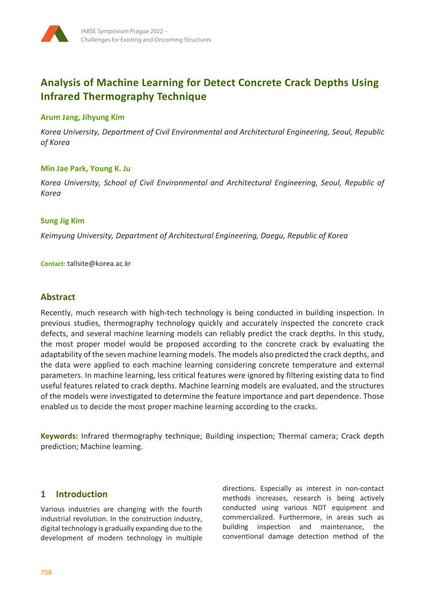Analysis of Machine Learning for Detect Concrete Crack Depths Using Infrared Thermography Technique

|
|
|||||||||||
Détails bibliographiques
| Auteur(s): |
Arum Jang
(Korea University, Department of Civil Environmental and Architectural Engineering, Seoul, Republic of Korea)
Jihyung Kim (Korea University, Department of Civil Environmental and Architectural Engineering, Seoul, Republic of Korea) Min Jae Park (Korea University, School of Civil Environmental and Architectural Engineering, Seoul, Republic of Korea) Young K. Ju (Korea University, School of Civil Environmental and Architectural Engineering, Seoul, Republic of Korea) Sung Jig Kim (Korea University, Department of Civil Environmental and Architectural Engineering, Seoul, Republic of Korea) |
||||
|---|---|---|---|---|---|
| Médium: | papier de conférence | ||||
| Langue(s): | anglais | ||||
| Conférence: | IABSE Symposium: Challenges for Existing and Oncoming Structures, Prague, Czech Republic, 25-27 May 2022 | ||||
| Publié dans: | IABSE Symposium Prague 2022 | ||||
|
|||||
| Page(s): | 758-765 | ||||
| Nombre total de pages (du PDF): | 8 | ||||
| DOI: | 10.2749/prague.2022.0758 | ||||
| Abstrait: |
Recently, much research with high-tech technology is being conducted in building inspection. In previous studies, thermography technology quickly and accurately inspected the concrete crack defects, and several machine learning models can reliably predict the crack depths. In this study, the most proper model would be proposed according to the concrete crack by evaluating the adaptability of the seven machine learning models. The models also predicted the crack depths, and the data were applied to each machine learning considering concrete temperature and external parameters. In machine learning, less critical features were ignored by filtering existing data to find useful features related to crack depths. Machine learning models are evaluated, and the structures of the models were investigated to determine the feature importance and part dependence. Those enabled us to decide the most proper machine learning according to the cracks. |
||||
| Copyright: | © 2022 International Association for Bridge and Structural Engineering (IABSE) | ||||
| License: | Cette oeuvre ne peut être utilisée sans la permission de l'auteur ou détenteur des droits. |
||||
